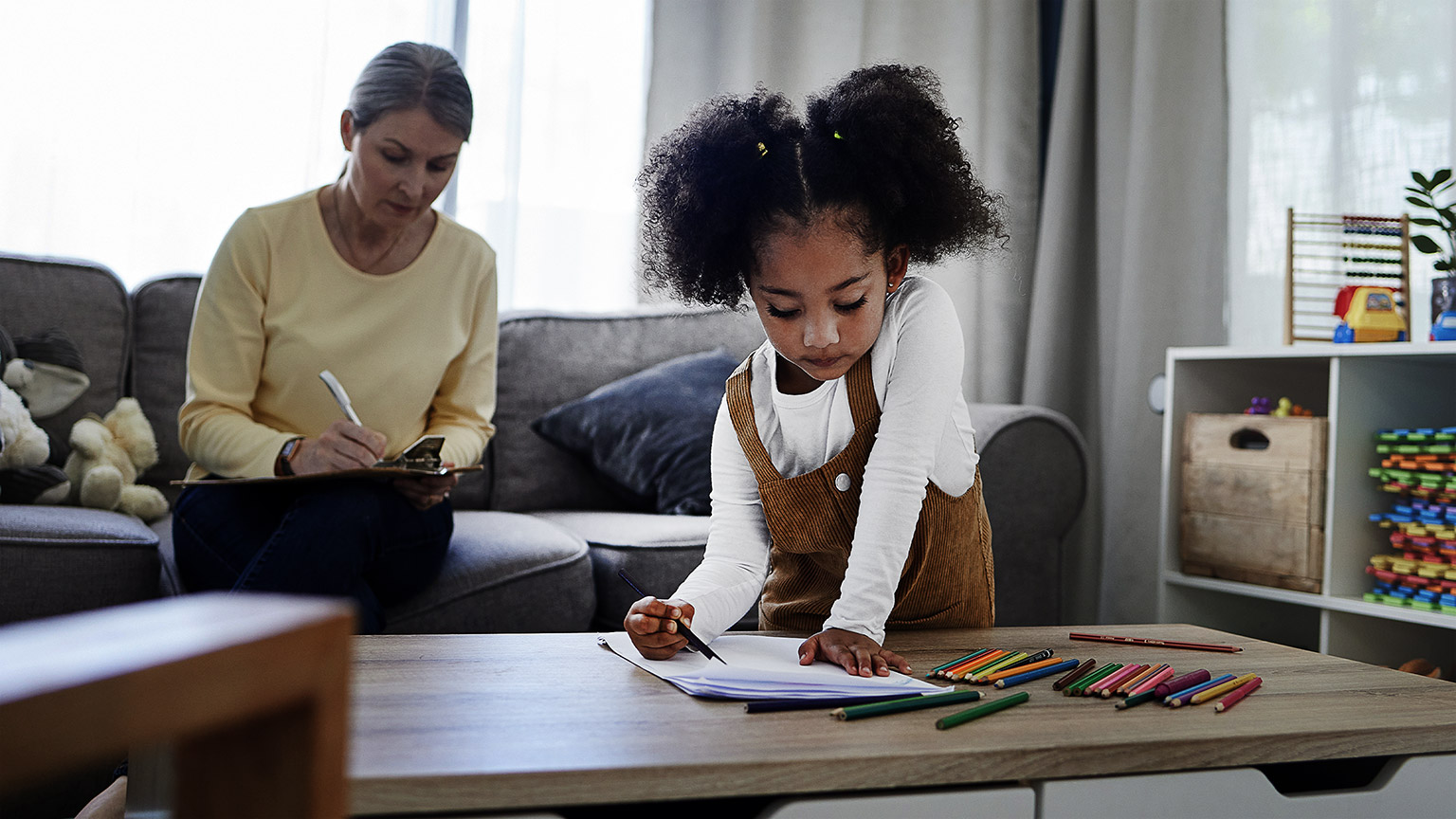In this topic, we will explore practices to ensure children have a safe and supportive environment. We will look at rooms, equipment and toys as well as hazards, monitoring access to the premises, and monitoring the arrival and departure of children.
By the end of this topic, you will understand:
- Verifying the safety of rooms, equipment and toys
- Protecting children from hazards and dangerous products
- Ensuring safe spaces for babies and toddlers to explore
- Monitoring adult access to premises.
Safe environments include the physical building and facilities of the service, such as toilet facilities and outdoor spaces. They also encompass all items and activities within the service, such as the storage of food and hazardous materials.
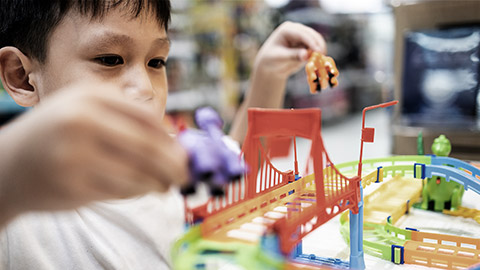
Early childhood educators need to be particularly attuned to the risks and safety of the spaces the children in their care use. All workplaces need to consider safe spaces. However, given the naturally curious nature of young children and their tendency to taste, crawl and examine everything around them – from a paperclip found on the carpet to the dangling cord of a window covering – your ability to ensure a safe space in your service is especially important and demanding.
Daily checks matter
Early childhood educators are required to ensure that the environment, toys and equipment are safe; and potential hazards have been identified and removed. An important part of the work involves daily safety checks and verifications of the environment. Daily safety checks include assessing indoor and outdoor areas. Services will develop a safety checklist that educators should use before the children enter their designated room environment and the outdoor environment.
The main ten (10) areas that should be checked daily for safety are as follows:
| Outdoor play space | Outdoor play areas should be checked daily for cleanliness and tidiness. Check for any debris or garbage. Check that fencing is not broken or damaged in any way. Ensure no animal droppings are in the play area and that there are no potential drowning hazards, such as puddles. |
| Entrance/exit and hallways | Check that entrance and exit areas, and hallways are properly lit and free of clutter. Ensure floor mats are lying properly so they are not a trip hazard. |
| Windows | Children are curious, and windows can be a fall hazard (even at ground level). Ensure they are properly locked and that all experiences are set up away from the window, and any curtain cords are out of reach of children. |
| Floors | Make sure that all dangerous items are removed from the floor. This can include small items, such as staples or pins; or larger items, such as toys and equipment that has not been packed away. Also consider the possibility of carpet and mats rolling and creating a tripping hazard. |
| Walls | Check that electrical outlets are securely protected, bulletin boards do not have pins or staples that can dislodge, and cords or fabric is not hanging from the walls or ceiling (these can be hazards to a child). |
| Furniture | It is important that furniture is checked to make sure it is in working order. Furniture should be placed in locations where it cannot fall onto a child. Where this a risk, the furniture should be attached to the wall. Supervision is required to ensure children do not climb on furniture. |
| Cots | Cots need to be in working order and up to the Australian standards for cots. The cot must have the product code AS/NZS2172. The cot should have no loose pieces, be in working order and have a functioning side gate that can move up and down when removing a child from the cot. |
| Toys and supplies | Toys and supplies should be checked regularly to ensure they are in working order. Broken or frayed toys need to be removed immediately and either fixed or disposed of. When reviewing or purchasing toys and resources, you need to consider the requirements of Product Safety Australia and ensure the product meets the standard code AS/NZS8124. To review different toy requirements, you can head to the Product Safety Australia website. |
| Kitchens and storage | Ensure storage lockers and kitchen areas are secured so children cannot enter them. |
| Toilets | Check toilets are functioning properly. Clean toilets daily and check them for hygiene after children have used them. |
| QA3 | Physical environment | |
| Standard 3.1 | Design | The design of the facilities is appropriate for the operation of a service |
| Element 3.1.1 | Fit for purpose | Outdoor and indoor spaces, buildings, fixtures and fittings are suitable for their purpose, including supporting the access of every child |
| Element 3.1.2 | Upkeep | Premises, furniture and equipment are safe, clean and well maintained |
| Standard 3.2 | Use | The service environment is inclusive, promotes competence and supports exploration and play-based learning |
| Element 3.2.1 | Inclusive environment | Outdoor and indoor spaces are organised and adapted to support every child’s participation and to engage every child in quality experiences in both built and natural environments |
| Element 3.2.2 | Resources support play-based learning | Resources, materials and equipment allow for multiple uses, are sufficient in number, and enable every child to engage in play-based learning |
| Element 3.2.3 | Environmentally responsible | The service cares for the environment and supports children to become environmentally responsible |
Key points
As an early childhood educator, it is important that you stay up to date on the latest Education and Care Services National Regulations.Regulation 103 requires that education and care services’ premises, furniture and equipment are safe, clean and in good repair.
| Regulation 103 | Premises, furniture and equipment to be safe, clean and in good repair |
|---|---|
| (1) The approved provider of an education and care service must ensure that the education and care premises and all equipment and furniture used in providing the education and care service are safe, clean and in good repair.
Penalty: $2000. |
|
| (2) This regulation does not apply to a part of a family day care residence that is not used to provide a family day care service.
Note: A compliance direction may be issued for failure to comply with this regulation. |
Outdoor safety
Outdoor play spaces provide children a great opportunity to practise physical skills, explore the natural environment, and engage and interact in larger play experiences with their peers. As educators we need to understand the difference in providing safety outdoors.
Outdoor play spaces can include:
- Mounds for play
- Moveable play equipment
- Fixed play equipment
- Natural play spaces
- Bike tracks
- A sandpit
- Steps and paths
- Water.
When setting up or supervising outdoor play spaces, you need to consider:
- Shade provided
- Safety guards for climbing equipment
- Space between experiences
- Supervision requirements
- Space to walk and run
- Choice of plants and trees
- Exposure to insects and animals.
When creating an outdoor learning space, services need to ensure they are implementing the National Quality Standard (NQS):
| QA2 | Children's health and safety | |
| Standard 2.1 | Health | Each child's health and physical activity is supported and promoted. |
| Element 2.1.1 | Wellbeing and comfort | Each child’s wellbeing and comfort is provided for, including appropriate opportunities to meet each child’s need for sleep, rest and relaxation. |
| Element 2.1.2 | Health practices and procedures | Effective illness and injury management and hygiene practices are promoted and implemented. |
| Element 2.1.3 | Healthy lifestyle | Healthy eating and physical activity are promoted and appropriate for each child. |
| Standard 2.2 | Safety | Each child is protected. |
| Element 2.2.1 | Supervision | At all times, reasonable precautions and adequate supervision ensure children are protected from harm and hazard |
| Element 2.2.2 | Incident and emergency management | Plans to effectively manage incidents and emergencies are developed in consultation with relevant authorities, practised and implemented |
| Element 2.2.3 | Child protection | Management, educators and staff are aware of their roles and responsibilities to identify and respond to every child at risk of abuse or neglect. |
Playground equipment
Once you have considered the setup of the outdoor learning environment, it is important to ensure the playground equipment is safe and that you understand the risk associated.
Playground equipment can include:
- Slides
- Ladders
- A fireman pole
- A-frames
- Balance beams
- Steps
- Tunnels
- Movable equipment.
Kidsafe NSW Inc. is a recognised organisation that guides early childhood services to ensure their outdoor learning environment is safe and compliant with the Australian standards for playground equipment.
The standards include information about requirements for:
- Height restrictions
- Fencing restrictions
- Entrapment
- Barriers, guardrails and handrails
- Portable mats
- Playground surfacing.
For more specific information on the required playground standards, review the relevant fact sheets at the following link:
- ‘Playground Safety Information Sheets’ from Kidsafe NSW Inc.
- Visit Kidsafe NSW Inc. to help you learn about and ensure safe outdoor spaces.
- Read the ‘Moveable Play Equipment’ information sheet from Kidsafe Australia to learn about the expectations for moveable playground equipment
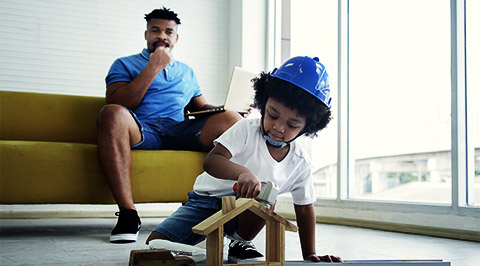
Children naturally undertake inquiry and explore the environment around them. This includes touching, smelling, tasting and listening to their surroundings, so ensuring the service environment has the correct safeguards against potential hazards and dangerous products are of high importance.
Types of hazards
There is a wide range of hazards to which you should remain alert in order to ensure the safety of children in your care. In this section, we will explore types of hazards, things to check in outdoor and indoor settings, poison prevention and toy hazards.
Common hazards can include:
- Toys and equipment
- Food
- Water play
- Doors or gates
- Windows
- Small objects
- Furniture
- Spills
- Cleaning material
- Powerpoint plugs.
Results of hazards:
- Trips
- Slips
- Choking
- Poisoning
- Crushing
- Burns
- Cuts, scratches, breaks, etc.
Outdoor hazard checks
Every day, before the children are taken outside for the first time, an educator should undertake a risk assessment of the outdoor area by completing the outdoor safety checklist.
Here’s an example of an outdoor safety checklist used at a childcare service from Little.ly Early Learning Centre:
- Dangerous items that can land in the outdoor area: Check for things such as debris, animal excrement and other foreign material that can find their way into the playground area (particularly sand pits).
- Hazards that are weather dependent: Standing water, hot or cold surfaces, and beehives or wasp nests can appear during certain types of weather or seasons.
- Hazards due to nearby building or other activity: Construction projects and other nearby activities can expose power lines, holes or equipment that is hazardous.
Indoor hazard checks
It is important to check indoor spaces before children arrive and also to monitor them throughout the day.
Food and drink
Ensure that floors, tables and play areas are kept free of spoiled food and drink. Also, ensure any wrappers or used food containers are picked up and disposed of.
Toilet and nappy-change areas
These tend to require constant checking for urination and soiling on the floor. You should also ensure all cleaning supplies have been properly stored or disposed of.
Technology
If a laptop, computer or other ad hoc equipment is brought in, ensure it is placed in an area safe from children and in a way where cords or other components do not introduce tripping hazards.
Here’s an example of an indoor safety checklist used at a childcare service from Little.ly Early Learning Centre:
- Equipment and toys should be age-appropriate, in good working condition and easily accessible by children.
- The environment should be clean, hazard-free, with clear entries and exits and with chemicals and medications stored safely.
Water safety
Children require constant supervision around water, including water play, excursions near water, hot water, drinking water and even small puddles. Children can drown in as little as 6 cm of water. Drowning is the leading cause of death in Australia for children aged one to four years. Your service likely has a water safety policy, and it is important that you diligently follow it.
Here’s an example of Little.ly’s water safety policy.
Four (4) actions you should use to ensure water safety are:
Water safety checks
- Monitor: Water play is to be supervised at all times.
- Daily check : Assess the outdoor area for trapped water every day before children enter the outdoor area.
- Containers : Ensure empty containers that are in a child’s reach are not left where they can collect rain water.
- Empty: When a water play experience has ended, ensure you empty the water before leaving the area.
The four supervision points
Early childhood educators have the responsibility to ensure the service’s children and environment are safe. In order to do this, educators have a responsibility as individuals and as a team to supervise children at all times in all experiences and routines. Educators need to assess the high-risk areas of the environment and times of day, and offer extra support and supervision. Supervision is at its best when covering the four supervision points.
Supervision goes far beyond just standing and watching. It is important that you perform the four supervision points while engaging with children.
 |
 |
 |
 |
| Scan | Listen | Position | Know |
|---|---|---|---|
| Scan the room frequently | Listen to what is happening or being said in the room. The sounds of silence can also indicate concerns | Stand with your back towards the wall or fence and ensure you are facing the majority of the space. | Know each child's abilities, temperament and level of support required. |
Poison prevention
To maintain and care for your service, you will undoubtedly have access to poisonous products, which include cleaning materials, gardening products and other chemicals. It is important that educators read the information and safety panels of each poisonous product and use and store the product as instructed.
Services will have a laundry cupboard and locked child safe cupboards for correct storage of all chemicals.
Early childhood educators must be vigilant in using and storing these items. Should staff or children come into contact with the poisonous product, educators should follow the safety instructions on the safety data sheet.
Educators always have the option of calling the Poison Hotline on 13 11 26, which is the same number in all states in Australia.
You can read more about poisoning on Health Direct’s website.
Note
Products that may be poisonous and to which children may be exposed include not only cleaning supplies and other chemicals, but also toxic paints and art supplies.

Key points
Cupboards and storage areas containing chemicals must be marked with a hazardous chemical sign.
Check your understanding
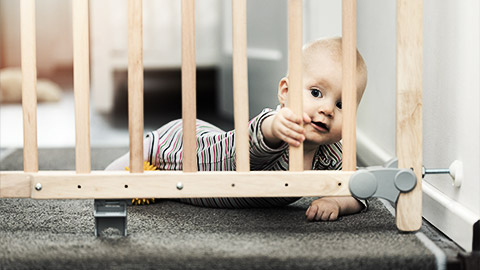
Babies and toddlers love to explore and test out new toys and spaces. They roll, crawl, run; throw and drop things, put things in their mouth; and climb on and hide in things. It is important to take care that their environment is safe to explore. Safe spaces encourage curiosity and exploration in addition to keeping children safe from hazards.
Note
Young children who constantly hear ‘Don’t touch that’, ‘No’ or ‘Give that to me’ often act out or withdraw due to frustration. If you find children showing challenging behaviours, it is a good idea to check the environment and ensure it is open and inviting for play, learning and exploration.
Creating a safe space
Creating safe spaces go beyond simply ensuring there are no hazards. It is important that the spaces provided for children are safe for them to practise gross, fine and perceptual motor skills; interact positively with the environment and others; and be challenged to think and understand.
Here are seven (7) tips to help you ensure the babies and toddlers in your care have a safe space to explore, where their natural curiosity will thrive:
-
It is easy to miss hazards when you are standing and looking around at adult height. Getting down and looking around at children’s height (even crawling height) shifts your viewpoint and can help you to see hazards you might not notice standing up.
-
Look at the arrangement of the space – the way it is set up makes a difference. Use furniture or barriers to cut off indoor areas that may encourage running. Separate learning and play areas, and look at how the furniture helps to direct movement or block it. Also consider if the way the space is arranged creates any supervision blind spots where children cannot be adequately supervised.
-
Is the area appropriate to cater to any additional support needs for children in your care? Be sure to create an environment that is inclusive. For example, you could make sure you have tables at a height that allows a child in a wheelchair to join in table experiences or create quieter areas for children sensitive to noise.
-
Organise toys and supplies to make them easy and safe for children to access. For example, you could position resources on low shelves and in baskets with pictures of the item on the front so the items are easily identified by all children.
-
Staplers and carts can be a real danger to children. Be sure that any equipment adults use is out of reach of children.
-
As a part of your daily safety checklist check all toys and resources for any breaks, fraying or missing pieces. Toys should also be regularly sanitised and washed particularly in baby rooms were toys are mouthed. Any resources that are not suitable should be removed and fixed or disposed of. Children should then be free to explore and engage with all resources in the learning environment.
-
Teach children to help with putting toys away. This can be a fun activity for even the younger children, even if they need more guidance and supervision. Remember, young children up to the age of 3 years of age are unsteady and can easily trip and fall. Also, depending on the child’s age and level of understanding, it is important to explain children how to use toys and equipment safely. Toddlers will need plenty of reminders and closer supervision, but older children are usually able to follow instructions and adhere to safety requirements.
Toys and Australian product safety
Another aspect of providing a safe environment is choosing toys for babies and toddlers that are age appropriate and support their development. Here are some important dos and don’ts to consider when choosing a toy:
Dos and Don’ts to use when choosing a toy
| Make sure infant toys: | Avoid toys that: | Take extra care that: |
|---|---|---|
|
|
|
Children should feel safe and free to explore their learning environment and the toys and resources within it. This means as educators we need to ensure that all resources and toys are suitable and in working order.
Educators need to ensure a toy or resource:
- Is in working order
- Is not broken or fraying
- Does not pose unsuitable risk to a child
- Is age appropriate
- Has no loose pieces, such as nails, screws or buttons
- Does not pose a risk of swallowing batteries
- Is unlikely to fall from its storage location
- Is unlikely to collapse
- Is non-toxic
- Can be easily washed and kept hygienic
- Does not have moving parts that could pinch a child’s skin
- Is not a choking hazard.
Educators are responsible for maintaining a safe environment and should regularly check toys and resources for any hazards or risks. This is often done through a daily safety checklist and cleaning checklist.
Services need to ensure they purchase resources from reputable companies. This will ensure the toys and resources meet the Australian Standards.
Services also need to consider checking and childproofing any donated resources or toys from families or the community before implementing them into the environment.
The Australian Competition and Consumer Commission provides comprehensive information on product safety for children's toys. Read about the risks; buying and safe-use tips for a range of children's toys; and recalled products of which you should be aware on Product Safety Australia’s website.
Educating children and setting limits
Another aspect of ensuring a safe space for young children to explore is involving them in the process of creating a safe space through setting limits and having age-appropriate education on safety. Involving children in this way helps to build safety awareness and creates a consistent structure for children to uphold.
Safe-practice limits could include expectations such as walking inside, packing toys away after use, asking for a turn or keeping our hands to ourselves. It is important to teach children the limits in a positive way where you explain how they help, and then be consistent in implementing them.
| Limits and abilities | When creating safe-space practices, consider the policies and procedures of your service, and the developmental abilities of the children in your care.
You might want to establish practices that vary by age group and have consideration for the abilities of the specific children participating. |
| Educating children | Take the opportunity to teach children about safety when you are leading activities—make the explanations practical and relevant, and deliver them in bite-sized chunks. Include children in creating room limits and guidelines. If a child has ownership of the safety of the environment, they are more likely to engage in the practice. |
Think
Take a few minutes and think about your service (or a group of children you want to work with): what would your safe-space practices and limits be? How would they be different for toddlers or for 3-5-year-olds?
Explore ACECQA’s website to learn more about Quality Area 2: ‘Quality Area 2 – Children's Health and Safety’.
All children have the right to experience quality education and care in an environment that provides for their physical and psychological wellbeing and provides support for each child’s growing competence, confidence and independence
NQS Quality Area 2 – Children’s Health and Safety
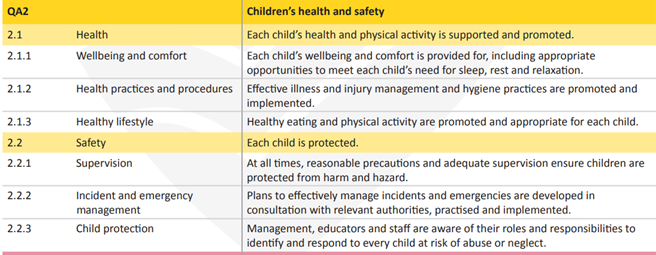
Watch
The following 3-minute video published by ACECQA explains the essence of Quality Area 2. Although there were many changes in the NQF since the video was originally published, the importance of children’s health and safety remained unchanged.
An important part of ensuring a safe environment for children is being aware of and helping to monitor adult access to your service.
Your ability to remain alert and attentive to who is coming and going from the centre is the first line of protection for children attending. We are going to explore the regulations regarding parent or caregiver access and visitor access as well as checks for people who work with children, and authorisation policies.
Premises access rights and risks
Authorised parents and caregivers are required to have access to the education and care service facilities their children are attending. In fact, they can enter the premises at any time. However, there are certain conditions where exceptions can be made:
| Safety risk | When the parent’s entry would pose a safety risk to the children and staff of the education and care service (e.g. the parent has clearly been consuming alcohol or drugs) |
| Conflict of duty | Where their entry would conflict with any duty of the provider, supervisor or educator under the law or a court order (e.g. a biological parent has a court order against them and therefore is not legally allowed access to the service) |
Note
Ensure you are familiar with the authorisation policy of your centre and you follow that policy.
Key points
As an early childhood educator, it is important that you stay up to date on the latest Education and Care Services National Regulations.
Regulation 157 requires that parents of a child being educated and cared for by a service may enter the premises at any time the child is present. It also describes specific exceptions to this access.
Monitoring access and intruder alerts
How can you tell if someone is in your childcare centre who should not be (an intruder)? The Education and Care Services National Regulations include two important regulations that cover recordkeeping of visitors—including signing in and signing out—and ensuring that children are never left alone with visitors.
It is important that you are aware of the specific practices at your service for visitor access and signing in and out. Also be aware of emergency procedures to follow in the event an intruder is found on the premises or you are alerted to an intruder.
Key points
The Education and Care Services National Regulations relevant to monitoring access are:
- Regulation 165, which requires that a service keeps specific visitor records that include name, signature, and time of arrival and departure.
- Regulation 166, which requires that children are not left alone with visitors to the premises.
You may also be required to have a Working With Children Check. Different states have specific check requirements for education and childcare staff. Know the checks required of you.
Aside from direct-care providers, background checks should also be conducted on any other adults who will be around children (e.g. cleaners, gardeners or incursion workers).
Note
In general, a service must ensure all educators, children and visitors sign in to the service on arrival and sign out of the service on departure. Educators and visitors must have the current checks in place to identify who they are (state-related checks or identification, such as a licence).
A service should always know the who, what, when and why of the people entering the service.
If at any time an educator (as well as co-workers) is unsure who the adult collecting a child is, the educator should ask for the person’s ID to ensure it matches those authorised for pick up in the child’s enrolment file. If the adult is not listed, the educator can call the listed primary carers to confirm. Authorisation forms must also be consulted in case of divorced parents where there is a valid court decision restricting one parent from collecting the child. These situations may be unpleasant to deal with at times. However, not following procedures can lead to serious legal consequences. Open and honest communication and knowing the procedures can often ease the tension.
Check your understanding
In addition to monitoring the access of visitors, it is important to track the arrival and departure of children.
Tracking systems
Some services still rely on a manual, paper-based attendance log, while many others use computer programs that require signing in and out to be done on a tablet or other computer device.
Watch
Watch the following 2-minute video from Storypark to see its software system, which includes monitoring the arrival and departure of children, in action:
Software systems such as Storypark and many others help to keep consistent logs of when children arrive at the service. They are typically password-protected systems to help ensure only authorised users access the data.
It is critical that these systems are consistently used. In other topics, we will cover emergency procedures where this type of data can quickly become integral to a child’s safety.
To learn more about the Storypark system, check out the company’s website .
Example
Look at Little.ly’s Acceptance and Refusal Authorisation Policy for reference.
Key points
As an early childhood educator, it is important that you stay up to date on the latest Education and Care Services National Regulations and how to use the arrival and departure tracking system at your workplace.
- Regulation 99 covers children leaving the education and care premises. It includes details for monitoring who a child leaves with, including a parent of the child or an authorised nominee. It also covers exceptions for a child leaving the premises, for example, medical, hospital, ambulance treatment; or other emergencies.
- Regulation 158 covers the necessity for approved education and childcare providers to keep attendance records. It covers the requirement to keep documented records of attendance that detail the child's full name, and arrival and departure days/times. These records must be signed by the adult bringing or collecting the child.
Check your understanding
Based on Little.ly Acceptance and Refusal Authorisation Policy, select the correct response for each scenario:
Use the following questions to check your knowledge. You can check the correct answer by clicking on the 'Answer' button:
-
List the ten (10) different areas that should be checked daily for safety.
- Outdoor play space
- Entrance/exit and hallways
- Windows
- Floors
- Walls
- Furniture
- Cots
- Toys and Supplies
- Kitchens and Storage
- Toilets
-
List four (4) benefits of completing an indoor and outdoor safety checklist daily.
- Ensuring physical safety before entering the indoor or outdoor areas
- Able to identify hazards
- Ensure the safety of children and staff
- Awareness of resources wear and tear and potential harms in the future
- Avoid and prevent accidents and injuries
-
Identify each of the four (4) supervision points and describe how you could implement these within an indoor or outdoor environment.
- Knowing – Get to know the children in the room and be aware of who requires close supervision due to behaviour or skill.
- Scanning – I will continually look across the room, scan each child, and play space for any possible concerns.
- Positioning – I will sit and stand in positions that allow me to see the whole space and supervise all children. where not possible other educators will be positioned in areas that are unseeable to me
- Listening – I will actively listen to the noises, silence and conversations in the room even when engaging with children to identify and prevent any behavioural or safety concerns.
-
How can you be sure whether a toy or resource is appropriate for an early childhood setting?
- Checking over the toy for broken / loose parts or functions
- Checking for the material of the toy or if t requires batteries
- Checking for any choking or sharp aspects of the toy
- Checking the requirements of the toy based on ACCC
-
What is your legal role as an educator for when children arrive and depart from the service?
